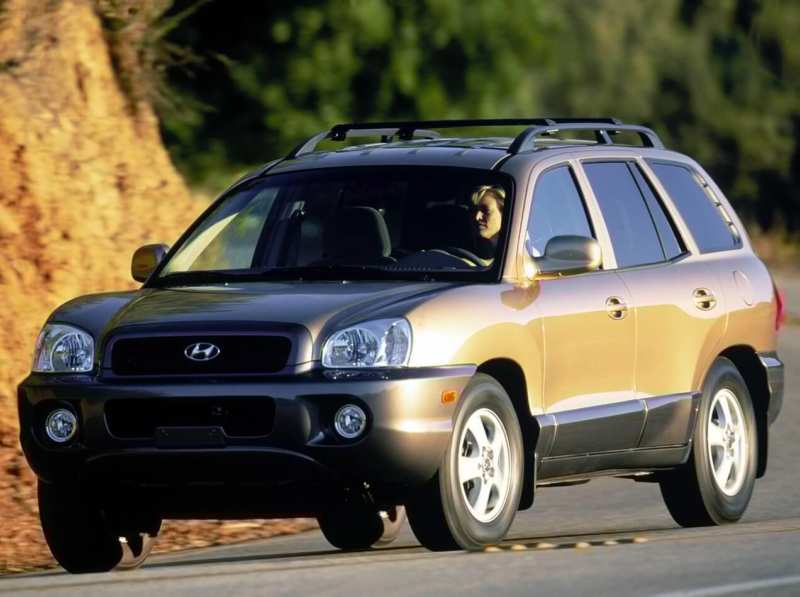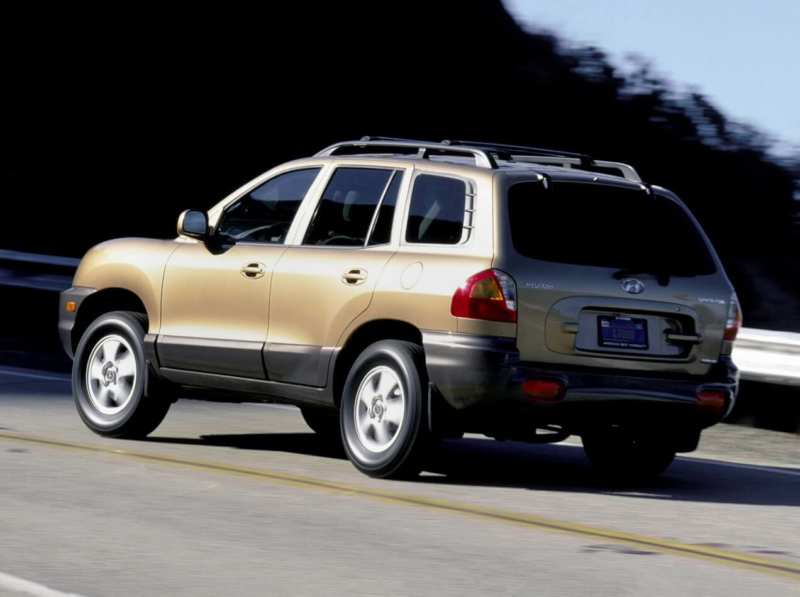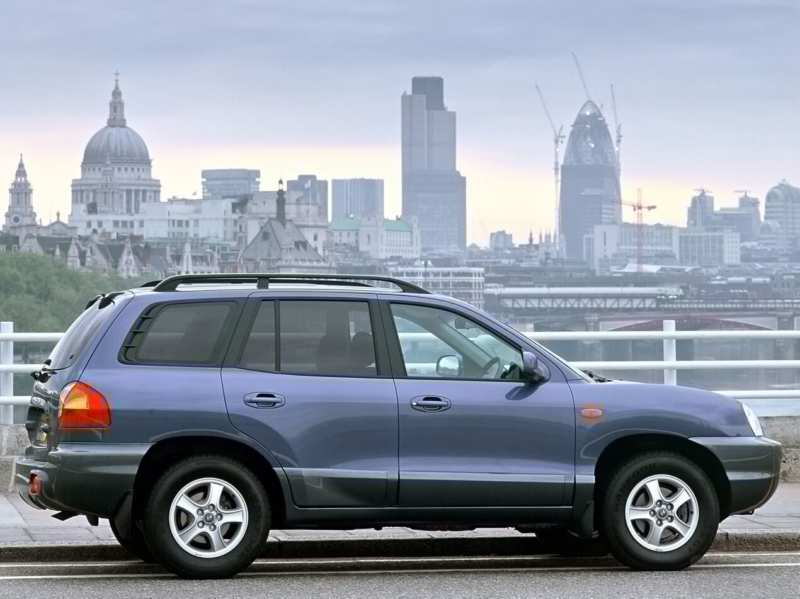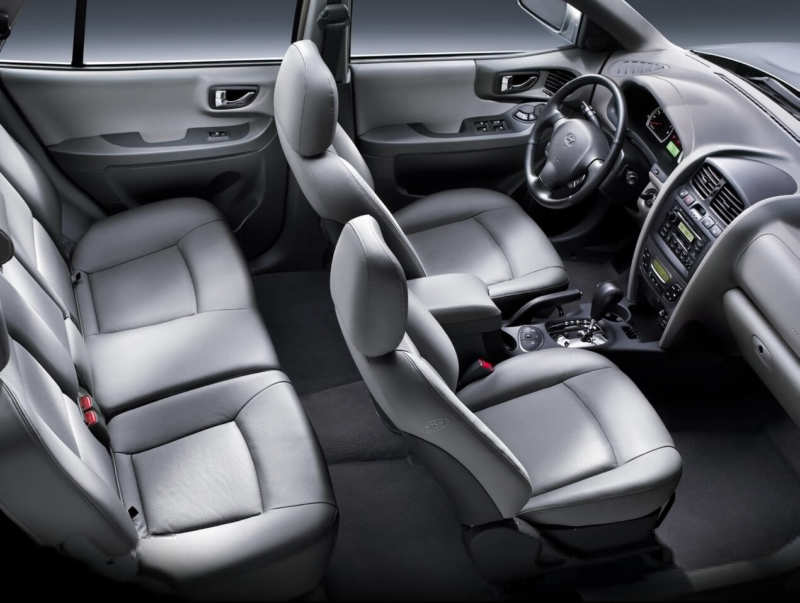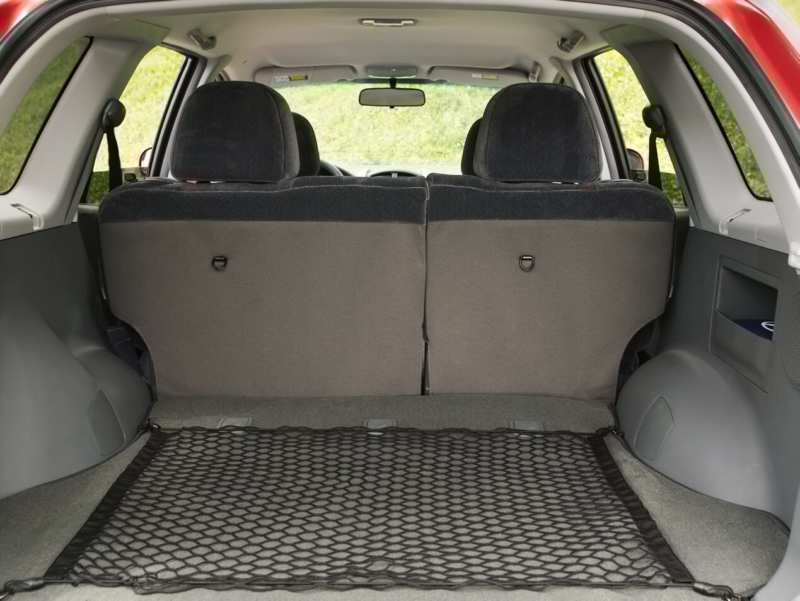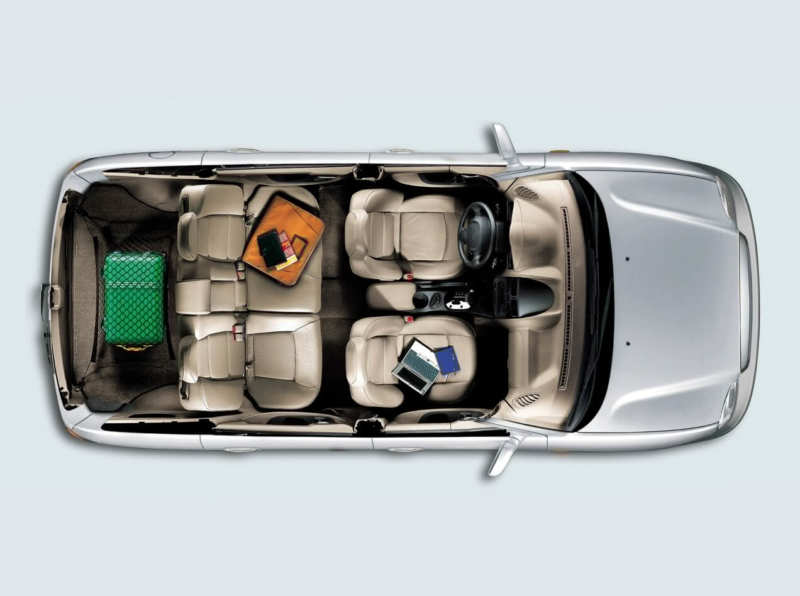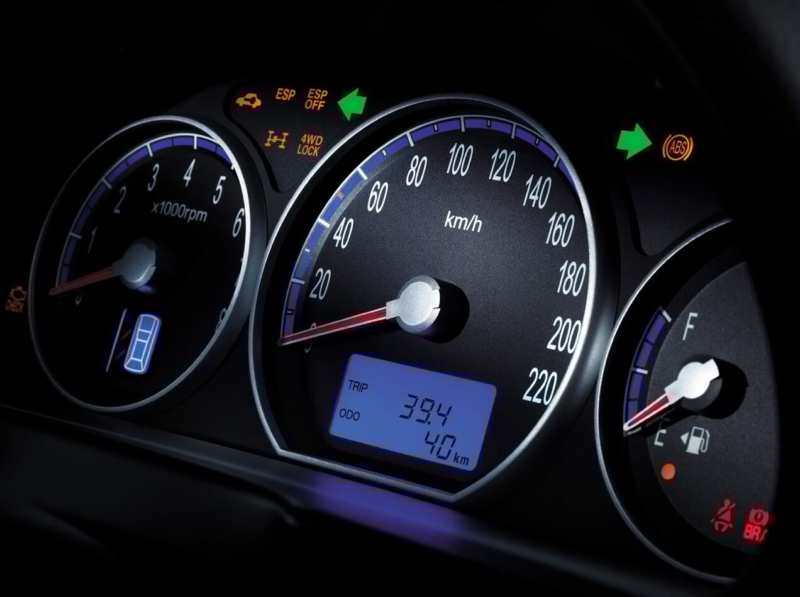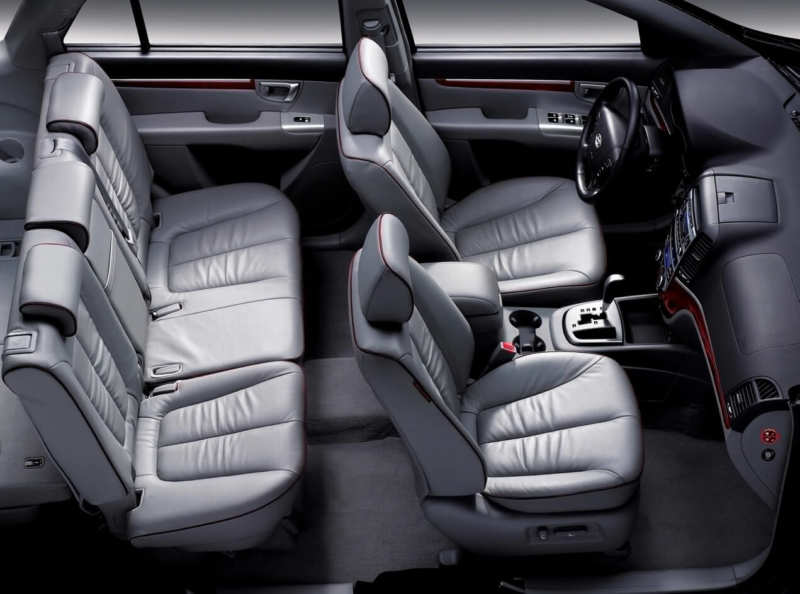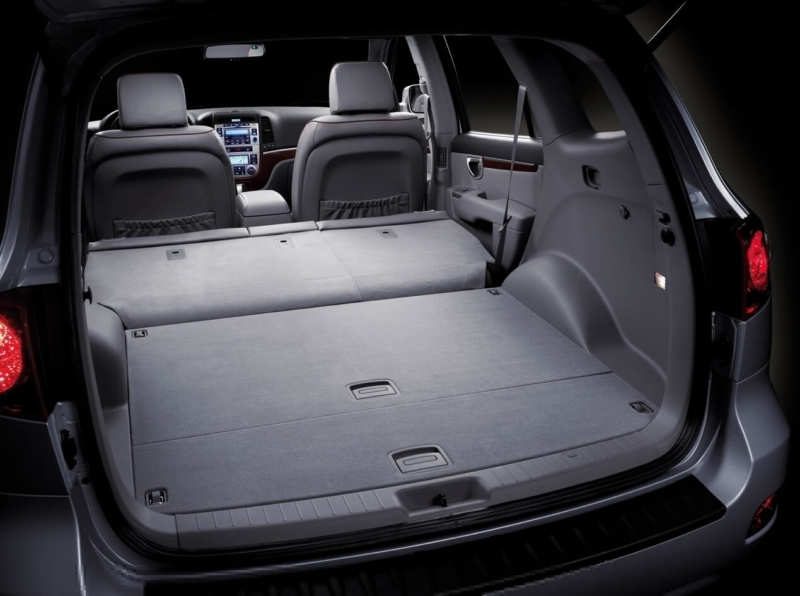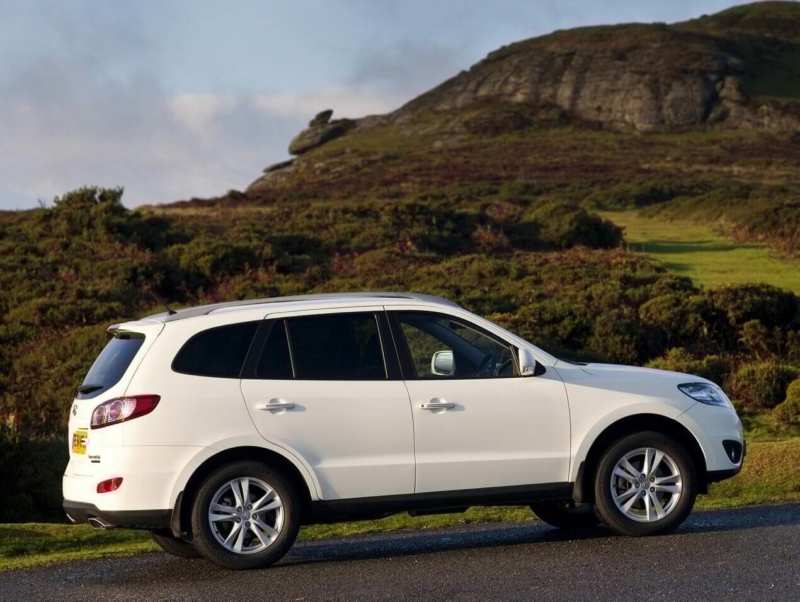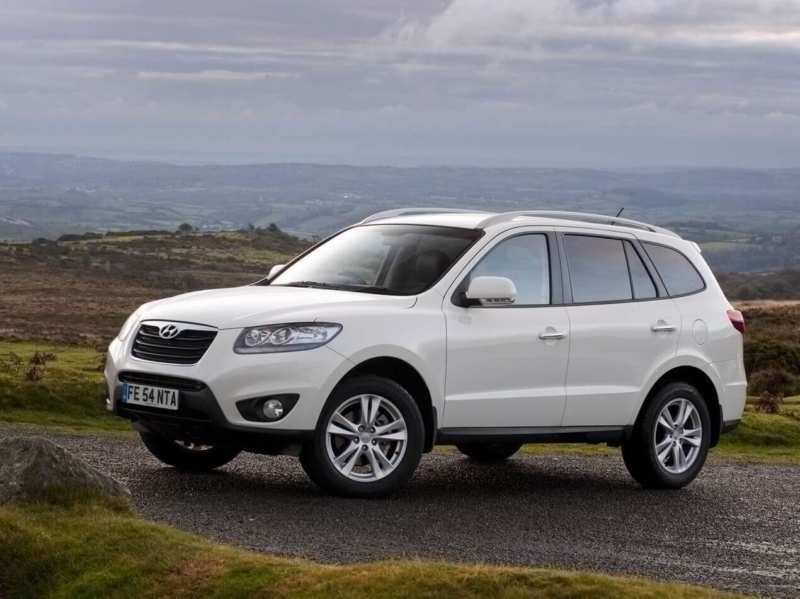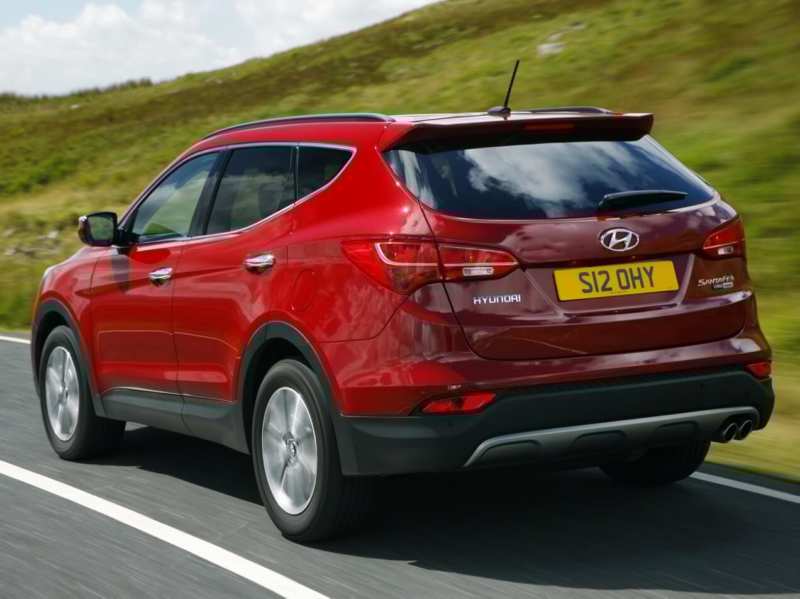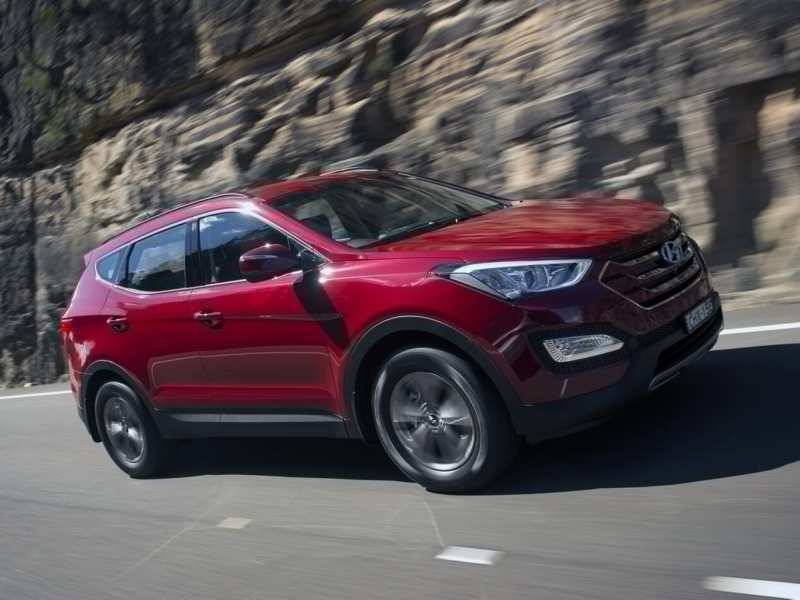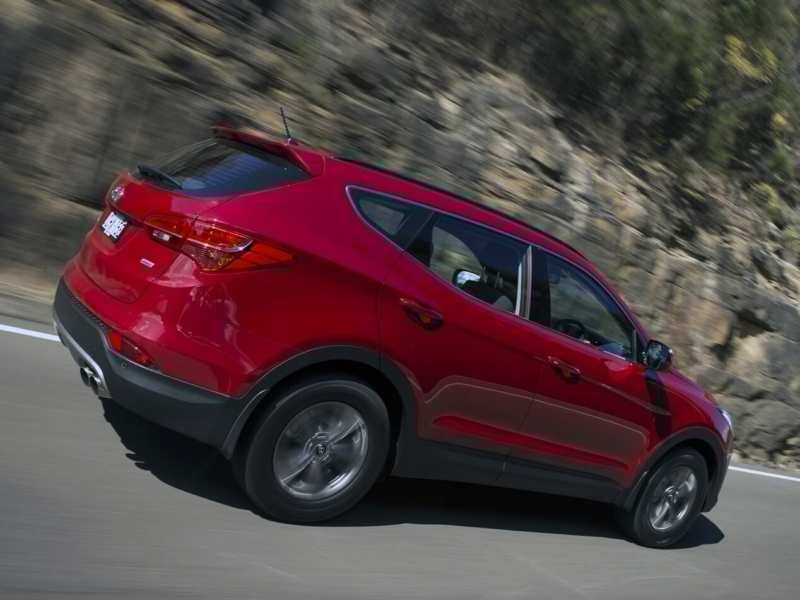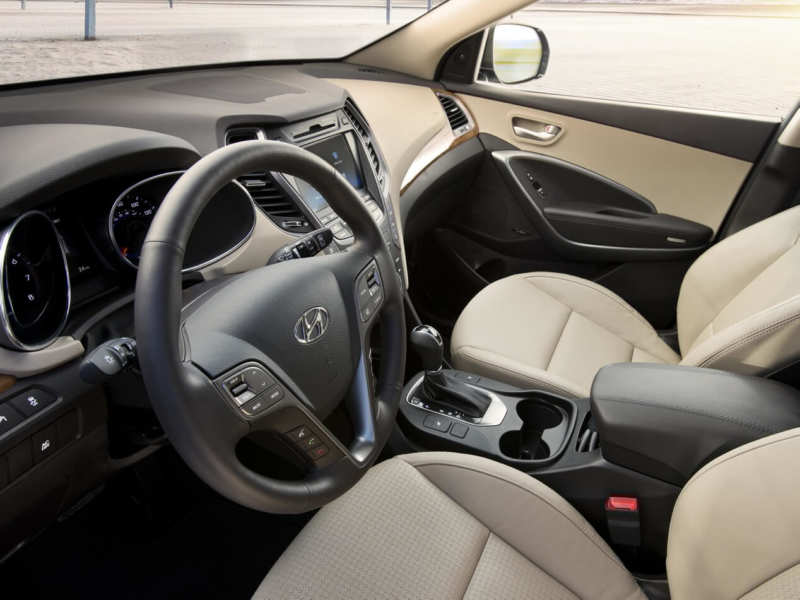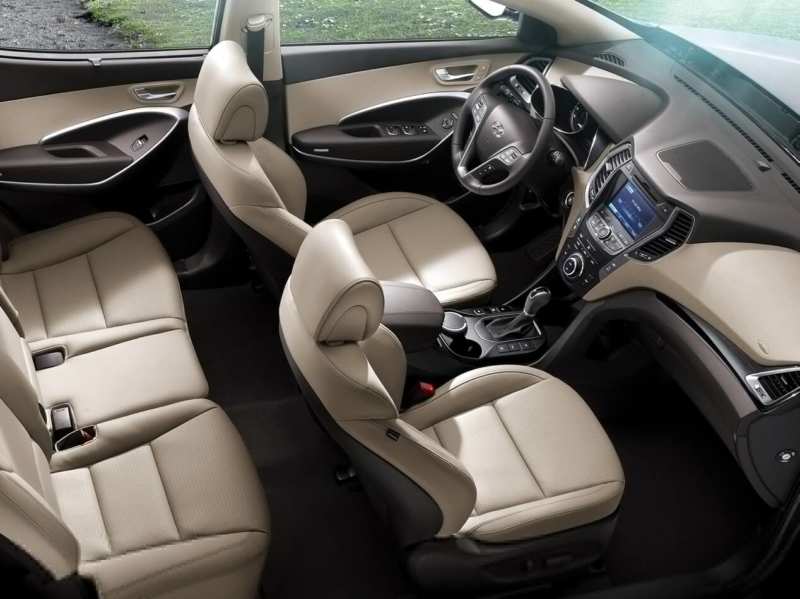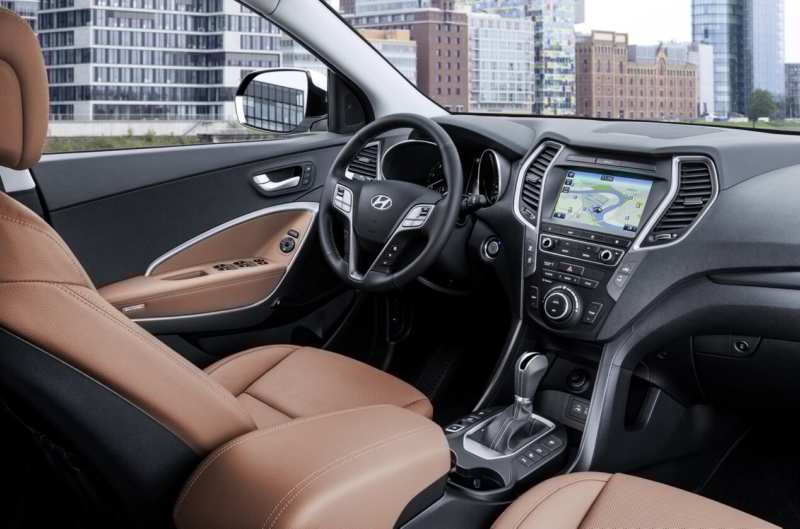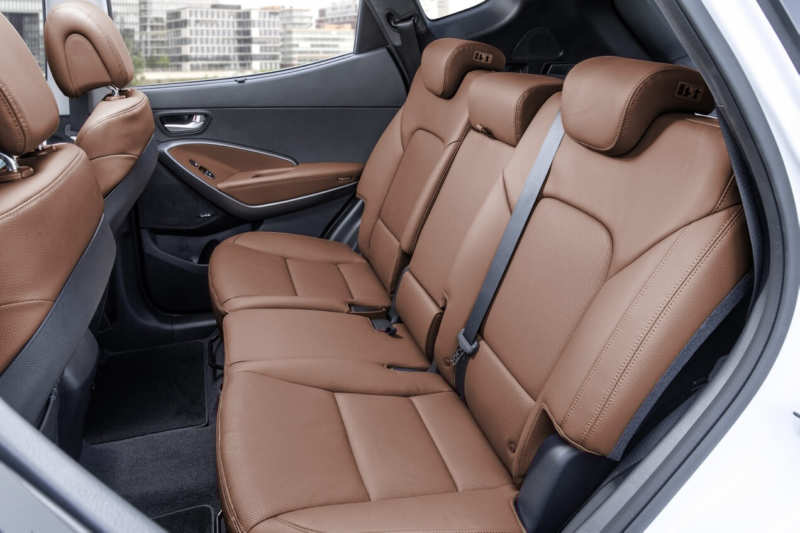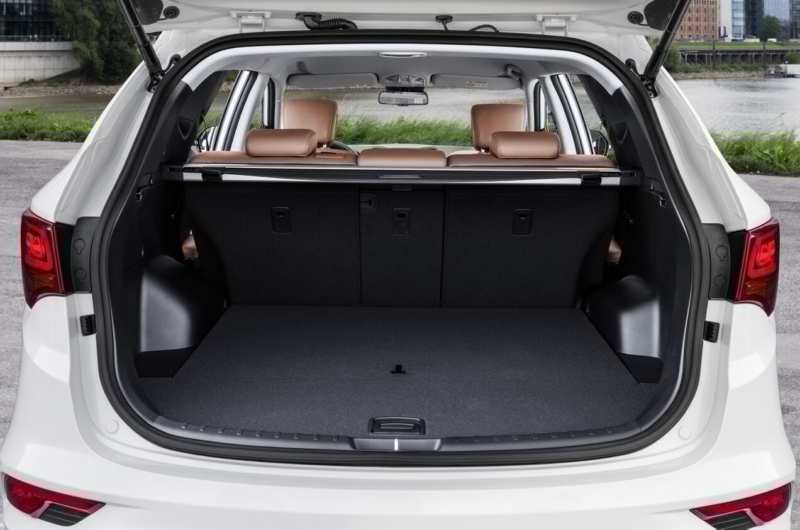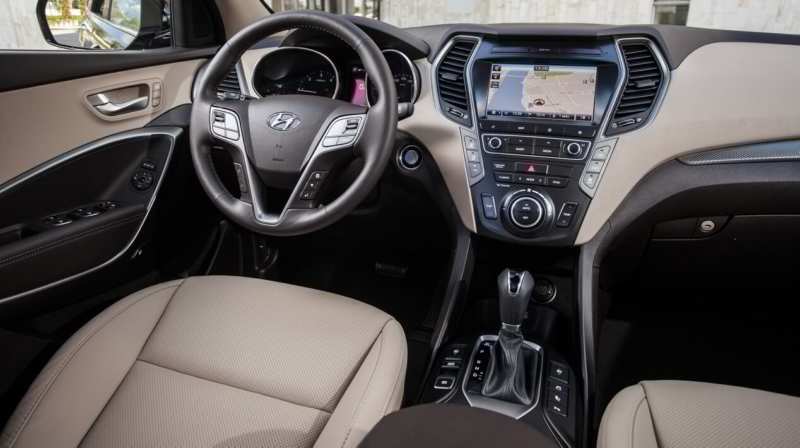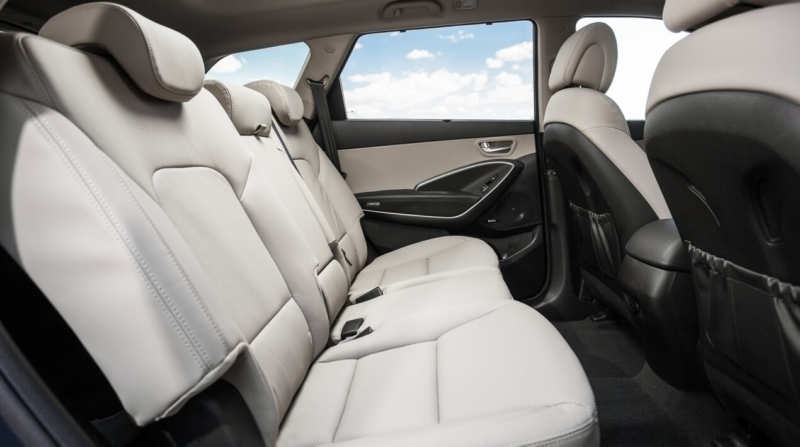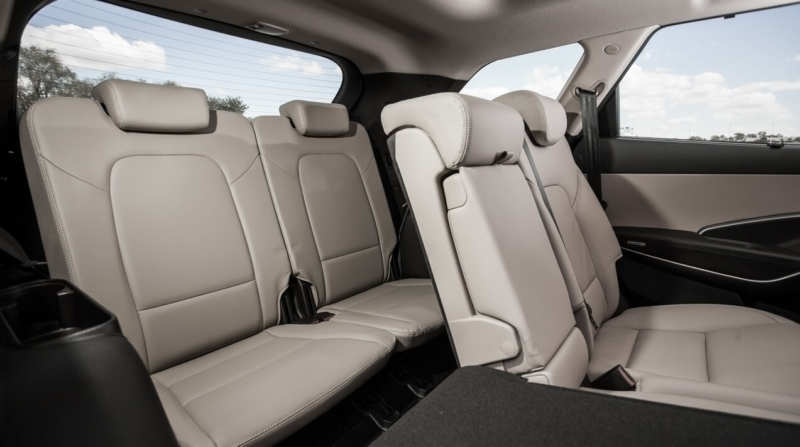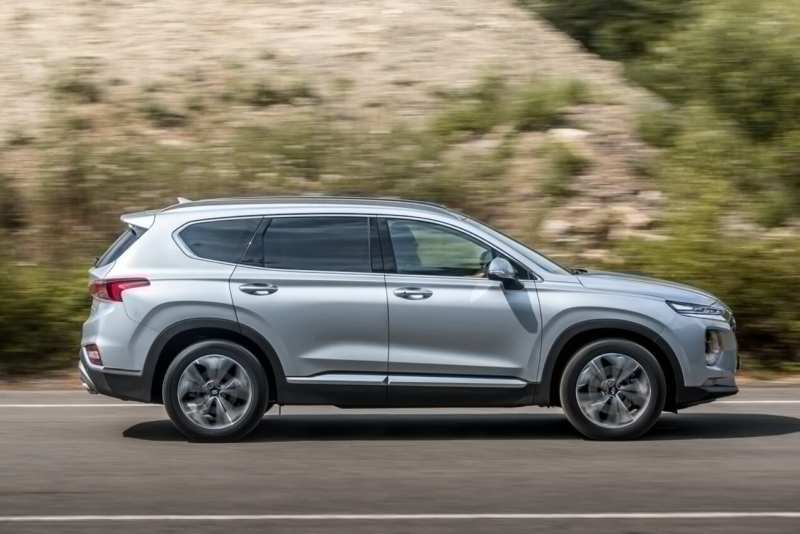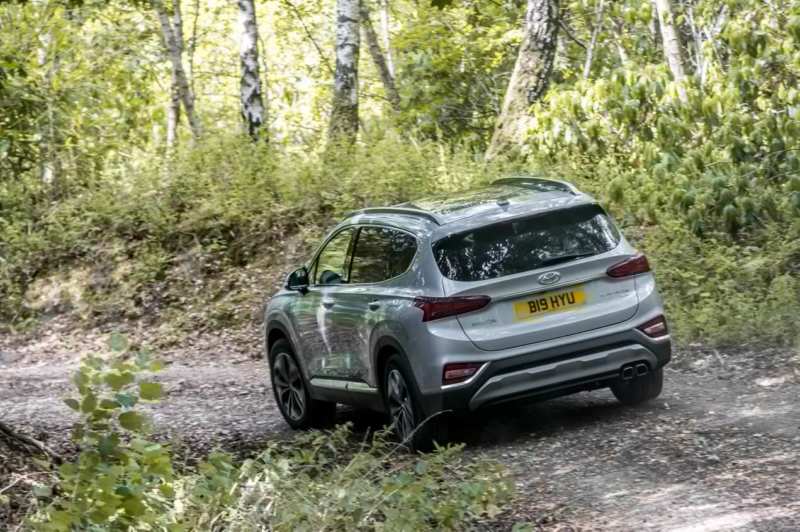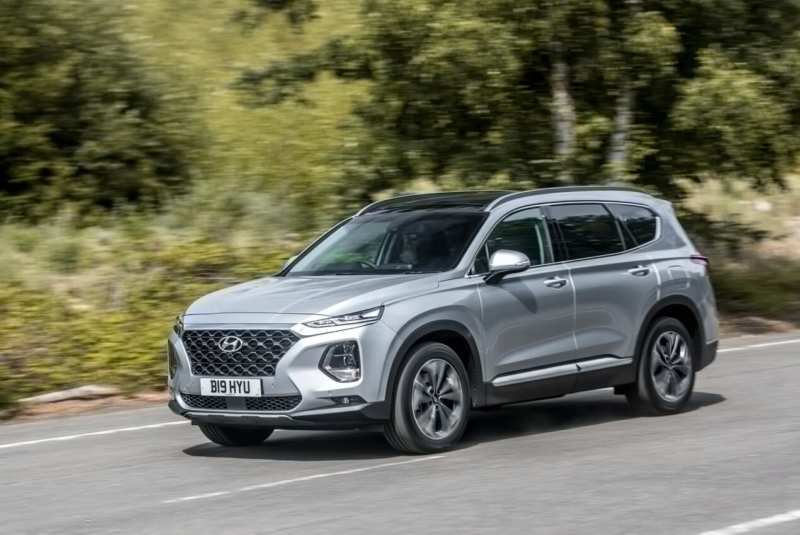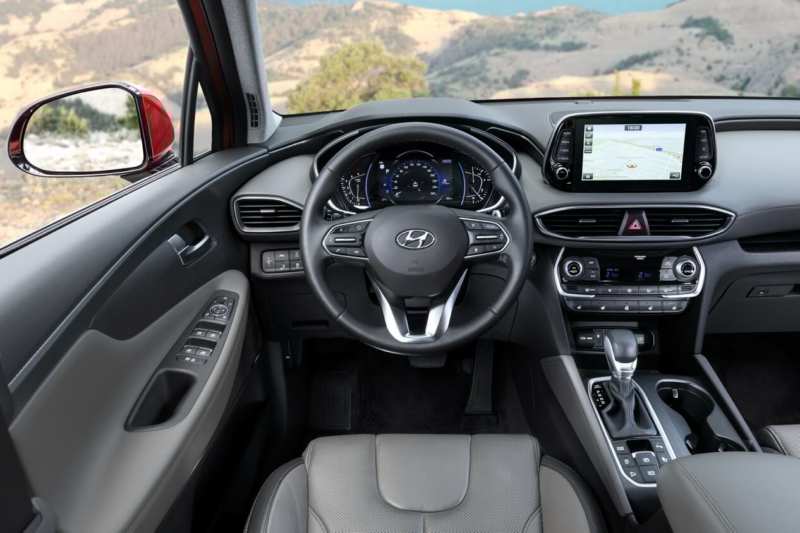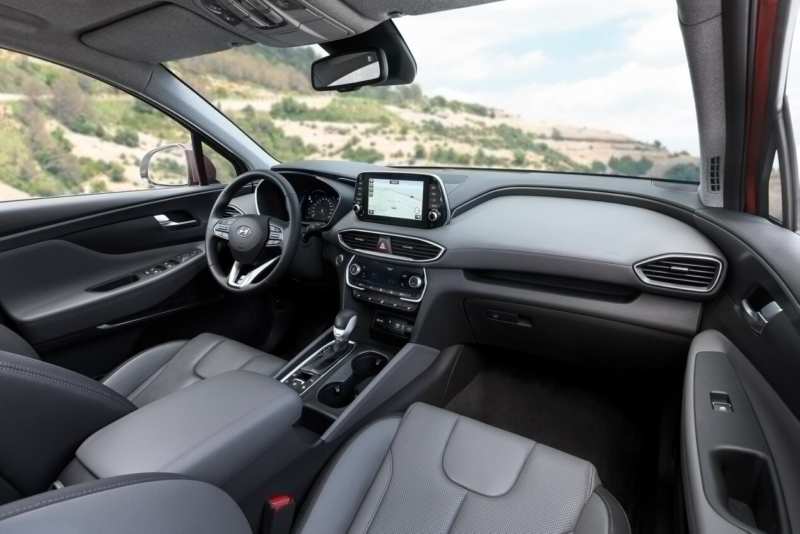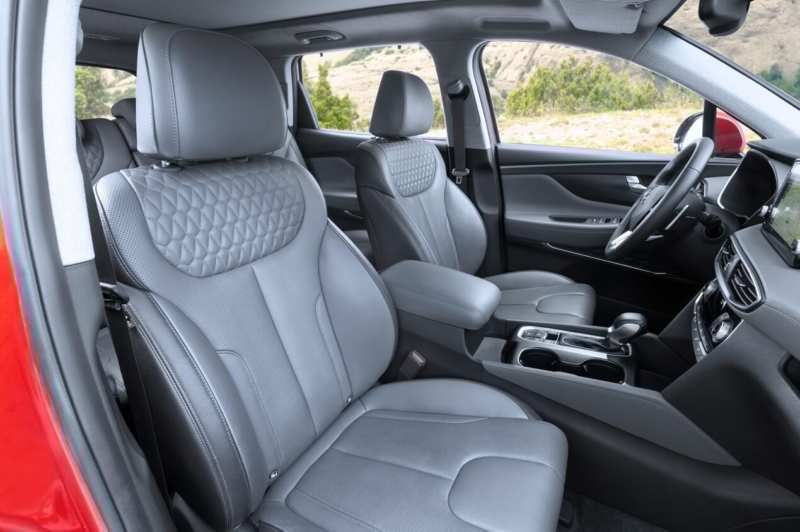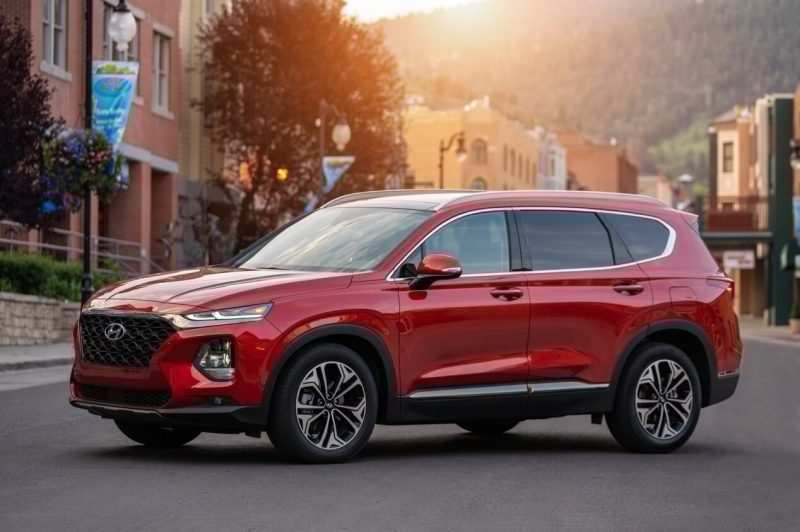Hyundai Santa Fe
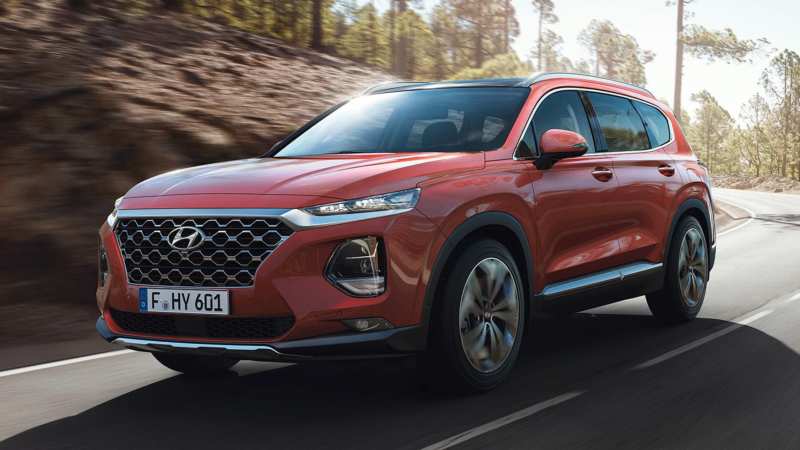
There was a time when Hyundai Santa Fe was able to “pave the way” for the Hyundai Motor Company in the crossover division. In addition, the South Korean company has achieved real success in the global market. Hyundai Santa Fe is a “medium size SUV” with a 5- or 7-seater interior layout, which has a front or four-wheel drive.
The car possesses good “driving” qualities, moderate passability, great practicality. There are only 4 generations of this vehicle. The last family of the new Hyundai Santa Fe 4 was officially presented in March 2018 at the Geneva Motor Show. The whole model range is Hyundai.
- Car history
- Santa Fe Classic (2000-2006, TAGAZ 2007-2014)
- II generation (2006-2012)
- III generation (2012-2015)
- Exterior
- Interior
- Specifications Santa Fe III
- Powertrain III generation
- Suspension
- Brake system
- Safety
- Stoitability and configuration
- 3 Generation Restyling (2015-2018)
- Seven Generation III Santa Fe (2012-2018)
- IV generation (2018-present)
- Exterior IV Generation
- Generation IV Salon
- Specifications IV generation
- Powertrain IV generation
- Transmission IV generation
- Generation IV chassis
- Safety IV generation
- Complete sets and prices of Santa Fe IV
- Comparison with competitors
- Owner’s Reviews
- Pluses and minuses
- We sum up
- Hyundai Santa Fe 2018 photo
- Test drive
- Video overview
Car history
I saw my debut, this car built on the basis of “Sonata” sedan, in 2000. Almost at lightning speed the car became a bestseller of the South Korean company in the United States market. After 2012, when the next “reincarnation” took place, the car received a seven-seater version with a prefix “Grand” in the name. The car is currently in steady demand, mainly in North America, with more than 120,000 vehicles sold each year.
Interesting that this car is the first crossover in the history of the company, which developed its own specialists.
Santa Fe Classic (2000-2006, TAGAZ 2007-2014)
The Korean company first officially showed its new product to Hyundai Santa Fe in 1999. The following year the car was put into serial production. Despite the fact that the new car was released along with such models as Ford Escape, Mazda Tribute and Pontiac Aztek, as well as criticism for its unclear appearance, the novelty has won the respect of motorists from the United States.
There were times when the plant did not have time to meet the demand and ensure the demand for cars. After the appearance of the 2nd generation of this crossover in 2006, the release of the debut version was transferred to the domestic automobile company. That’s why Taganrog Automobile Plant (TagAZ) began to produce the car.
Hyundai Santa Fe 1 generation was produced when the machines from Korea were simple in design, but reliable and fully meet the goals of the crossover. And many people forgave the unusual appearance due to the low cost. Just a simple and reliable approach has allowed the “Korean” to gain universal respect. It is interesting, but even today it is possible to find crossovers in a good condition.
The specialists of the company did not set the task to attract customers with chrome, bumpers, moldings, bright colors, unusual lines and other modern technological “lotions”. Therefore, Koreans have saved on the work of the design team. Hardly anyone will say anything bad about the eternal classics, which always remains in fashion.
Such associations appear when you look at the appearance of Santa Fe Classic. There are huge sizes, smoothed corners, cast “rollers”, tinted glasses. All this causes a certain stability, location, a sense of trust. The appearance of Hyundai Santa Fe 2000 has a large size, as well as streamlined shape.

After a calm appearance, entering the salon of Hyundai Santa Fe of I generation there is no sharp difference, for which the workers of the plant should be praised separately. Here it is possible to meet sound and qualitative internal furnish, convenient armrests and armrests, high noise isolation, smooth driving, good traction.
Decorative material of the salon decided to choose the skin or velour. Designers have well thought out the issue of ergonomics, so everything you need is always close by. They have not forgotten about the high landing and height-adjustable steering wheel. The driver is not distracted from the steering of the vehicle. There is a rack and pinion steering.
The cleanup is simple, but informative at any time of day. The driver’s seat can be adjusted in height mechanically and has a lumbar support and side support. Absolutely all seats are equipped with an adjustable angle of inclination of the backrest. A 2-section armrest and a pair of sockets are placed at the front.
There is a drawer under the front passenger. Inside there is enough space for all passengers, so the question of spaciousness disappears. It is possible to set a certain temperature mode, using a modern climate control system. And a flat floor will be formed. In the trunk niche under the tool mat there is a 12V socket. It is also nice that you can separately open the rear window, which is very helpful in close parking.
In the first year of production this vehicle was equipped with a couple of power units operating on gasoline. It was an economical and low-power 2.4-liter engine, which produced 150 horsepower. It worked together with a five-speed manual transmission or four-speed automatic transmission.
The drive was only on the front wheels. It was followed by a V-shaped, six-cylinder, 2.7-litre, 173-horsepower unit, which received an automatic transmission with all-wheel drive system. At the end of the first generation, its power increased to 125 hp.
Speaking for the suspension, it received a non-standard solution, as for off-road versions of the time. Hyundai Santa Fe of the first generation has a completely independent suspension, with McPherson racks in front of it, and double levers in the back, a large margin of safety, even considering the quality of domestic roads.
Korean’s advantages include good smooth running. The permanent all-wheel drive system is able to distribute the torsional forces in the proportion of 60 percent to the front and 40 percent to the rear. As soon as the slippage of the viscose coupling starts, the differential between the axles is blocked.
A car of the first family has a “licensed copy” in the form of a Chinese crossover JAC Rein.
The 2002 version of the machine has already increased fuel tank up to 71 liters. (previously there was a 64-liter tank) and minor changes inside and outside. I liked the introduction of two-color interior coloring. After 2003, the crossover had a 200 horsepower V6 engine with a volume of 3.5 liters, as well as a five-stage automatic box. With the advent of 2005, the model moved a small facelift, affecting the shape of the grille, rear bumper and “dashboard”.
II generation (2006-2012)
The next family of Santa Fe cars was officially shown in 2006 during the Detroit International Exhibition. Already in the spring of the same year, the model began to sell. During the show in 2010, which took place in Frankfurt, an updated car was produced, which received a fresher appearance, improved interior and a couple of new diesel engines.
Serial production of the crossover from Korea continued until 2012, giving way to the next third generation. The second version of the Korean car seriously stands out from the first one. The debut models were assembled only at the plant’s line in Montgomery (USA). After 2009, the company established production in the Czech Republic. And since 2007, Hyundai Santa Fe II appeared in a number of European countries with some changes. The novelty occupied an intermediate niche between ix35 (Tucson) and ix55 (Veracruz) crossovers.
The Korean crossover looks massive, solid and powerful for its time. There are smooth lines and body shapes that are common for many crossovers. The force is eloquently evidenced by the massive side parts, large radiator grille, expressive wheel arches, Asian head optics and two trapezoidal exhaust pipes. If you cover the company’s nameplate in the front of the car, you can take the “Korean” as a more prestigious car.
Larger wheels only emphasise the respectability of a comfortable crossover. Hyundai Santa Fe’s 2nd generation clearance height is 203 millimeters, which is very good. The upgrade has provided the five-door with a new bumper, body-colored false radiator grille, fogging and new roof rails. The wheels have a new design and a diameter of 18 inches.
Interestingly, in 2006, the second generation of Santa Fe set the world record for fuel efficiency in the medium sized crossover environment.
Hyundai Santa Fe 2 off-road vehicles have a fairly standard, attractive and comfortable interior. The dashboard, which has received three round windows of indicators, looks pleasant. The top-of-the-range interior is made of leather, the box in the driver’s armrest is cooled, and there is a light sensor.
Hyundai Santa Fe 2 has an automatic front seat positioner with eight positions. Many drivers were delighted with the rear camera, which displays the image on the display mounted in the mirror. Some versions received audio systems with control buttons on the steering wheel, electronic assistants ABS and climate control with the option of ionization of the air.
The helm itself is beautiful and has a metal decor. Dark wood panel finish can emphasize the overall style of the vehicle. The second family has received new fonts of dials and shade of illumination which became more pleasant, in comparison with the first generation. They have not forgotten to equip the car with a wireless Bluetooth headset that makes operation more convenient.
Car owners say that the seat heating function is of good quality – it is actually comfortable and can be easily adjusted. Hyundai Santa Fe 2 received an immobilizer, central locking and powertrain button, and the possibility of safe keyless access to the cabin. There is plenty of room for the rear passengers.
The driver’s seat and the front passenger seat have side support and electrical adjustment function. The second row has a wide armrest with cup holders, and the backrest can be adjusted to the angle of inclination. The luggage compartment now has an increased volume of 774 litres, and if necessary, you can put the backrest in a flat floor, which will provide 1,582 litres of useful volume.
Russians received two power units for the “second” Santa Fe. The standard version is a four-cylinder, atmospheric, 2.4-liter power plant, which received a distributed fuel injection. As a result, the engine develops 174 horsepower and 226 Nm.
Next comes a diesel, in-line, four-cylinder, 2.2-liter turbocharged engine. All this allows the engine to give 197 horsepower and 421 Nm of torque. For any engine you can choose a manual or automatic transmission (both have 6 speeds). Already in the base crossover Hyundai Santa Fe 2 has a four-wheel drive system, which in normal circumstances transmits all efforts to the front wheels.
But if one of the wheels starts slipping, up to 50 percent of the rotation force goes to the rear wheels. This process is monitored by the multi-disc friction clutch of the electronic control system. The gasoline power plant is accelerated up to the first hundred in 10.7-11.7 seconds, and the maximum speed is 186-190 kilometers per hour. A diesel engine is slightly “live” – 9.8-10.2 seconds to a speed mark of 100 kilometers per hour. The speed limit does not exceed 190 kilometers per hour.
The mixed cycle of the 174-horsepower plant requires 8.7-8.8 liters, and the diesel version requires 6.8-7.2 liters for every 100 km. As a basis for Santa Fe 2, they decided to use a front-drive architecture from the Hyundai Sonata sedan. The structure of the front suspension has shock-absorbing columns McPherson, and the rear axle – an independent multilever suspension. The steering system has a hydraulic power steering, and the braking system is equipped with circular disc brakes (the front is ventilated), as well as electronic assistants ABS and ESC.
Safety Hyundai Santa Fe 2 generation is not the last place. The first generation car has passed crash-tests, which showed a high level of safety. But the performance of the second family of Santa Fe has only improved. Machine has front and side airbags, belt pretensioners and air curtains. For the quality of passenger safety, experts have provided active head restraints.
Official dealers presented their crossover in 4 versions: Base, Comfort, Style and Elegance. The standard version of Hyundai Santa Fe 2 received a gasoline engine, manual transmission and front drive. This version of Base cost 1 079 900 pp. It has front and side cushions, safety shutters, belt pretensioners and active head restraints, ABS and EBD electronic assistants, immobilizer, front seat heating, 2-zone climate system with ionization function.
There is also a central lock, “music” with control buttons on the steering wheel, upholstery of seats and 17-inch “rollers” made of light alloy. The all-wheel-drive version had a turbo-diesel engine and automatic transmission in the version Elegance+Navi – 1 654 900 ppm. This version had:
- ESP;
- xenon headlamps with washers and automatic corrector;
- parking sensors;
- electric adjustments of the driver’s seat in 8 directions;
- electric adjustment of the passenger seat;
- Rear camera;
- with no key access to the passenger compartment and the engine start button.
It is important that the “top-of-the-range” version is equipped with a tire pressure monitoring system, cooled box in the driver’s armrest, electrically operated hatch, cruise control. The Koreans have not forgotten to install a navigation system, light sensor, leather interior decoration, heat-resistant windshields and cast “rollers” with a diameter of 18 inches. Secondary market offers to buy the second generation of Korean crossover Hyundai Santa Fe from 700,000 to 1,200,000 rubles.
III generation (2012-2015)
Exterior
The next 3rd generation of the medium-size Korean 5-seater crossover was released in the summer of 2012. The novelty became the first model to embody the new design concept of the brand “Storm Edge”. In European countries the vehicle is called Santa Fe Sport, and in our country it is just Santa Fe.
Korean specialists were able to combine a high level of safety, comfort and advanced quality of performance with modern filling. All this allows the machine to easily compete with more “famous” European giants.
Blockquote>In 2012, the 3rd unit of the car passed Euro NCAP tests and showed excellent results – a maximum of 5 stars.
The appearance of Hyundai Santa Fe of the 3rd generation was created in the concept of “flowing lines”. In fact, everything looks great. The appearance is both attractive and smooth, but devoid of anything shouting or eccentric. The front end has a large, chrome-plated radiator grille, two-color front bumper, sharpened optics and fog lights, as well as a sloping hood.
There is an optic with LED filling with an interesting shape. Looking at the front of the Hyundai Santa Fe III, it is simply impossible to confuse the car with another brand. The side part is intriguing – there are proportional and harmonious lines. There are massive doors, which have been stamped at the bottom and at the top, which capture the entire rear wing and a little bit of the front.
The gas tank is equipped with a round hatch. It couldn’t do without small rear windows and a little bit overwhelmed roof. The entire silhouette of the Korean crossover Hyundai Santa Fe 3 shows the aggressiveness and sporty mood. The height of ground clearance on the third generation was 185 millimeters.
The rear part looks pedigree, has double exhaust, effective wing and stretched feet. There are also LED elements. The spoiler has a duplicate stop signal. The vehicle can be recognized by the plastic dodger around the entire perimeter of the car, which successfully harmonizes with the large “rollers” of the light alloy. The rear bumper is also protected by reflectors.
Interior
The interior of Hyundai Santa Fe III was made qualitatively, soundly and in the corporate style of the company. There is a wave-shaped torpedo decorated with uniquely shaped holes in the ventilation system, as well as a nice and informative “device”. The dashboard itself has soft blue illumination and deep wells, in which the sensors of a speed mode and quantity of turns of the power unit hide.
The central console has a large screen under a special visor, which improves visibility and prevents glare. Inside, a beautiful 3-spoke steering wheel, reminiscent of a letter “V” and received the organs to control the multimedia system, is immediately striking.
Underneath the display is the options control department. Visually, this area is highlighted by 2 “torsionals”, on all sides of the studded keys. Ergonomics is above all praise – all at hand and the driver does not need to reach any controls. The gear shift lever is convenient, and the keys around it fit well into the overall picture of the interior.
Only high quality materials were used during the finishing process. There is plenty of free space for all passengers on both rows. The seats themselves are comfortable, they have excellent side support and a lot of adjustments. The second row is made for two adult passengers and is equipped with an armrest and other nice little things.
Hyundai Santa Fe III presents the first car designed within the framework of the newest design solution “Storm Edge”.
Owners note a good level of noise insulation crossover. To do this, a group of engineers decided to use thicker glass and special insulation mats to confidently protect passengers from external noise, wind whistling and motor sound.
Generally speaking, the cabin was adjusted to the “standards” of premium cars. There is plastic, but it is expensive and pleasant. There are no backlashes, curves and problems with inconsistencies in the front panel. Korean engineers managed to take into account all the mistakes of previous generations and make a really cozy car with a high level of comfort.
Specifications Santa Fe III
Powertrain III generation
The technical part of the “third” Santa Fe received two power units. The base is considered to be an improved gasoline power plant Theta II, which received a working volume of 2.4 liters, which develops 175 horsepower. The engine received a new system of distributed gasoline supply with adjustable geometry of injectors and meets environmental standards Euro-4.
Maximum speed is 190 kilometers per hour, and the first hundred is reached by Hyundai Santa Fe III in 11.4 seconds with a mechanical box and 11.6 seconds with an automatic box. Consumption of such an engine is about 8.9 liters of fuel in combined mode, 11.7/12.3 liters in the city (with a mechanical and automatic box), and on the highway – 7.3 and 6.9 liters, respectively.
In the role of the second decided to use a diesel 2.2-liter engine. The engine is called R 2.2 VHT and produces 197 horsepower. There is a Common Rail injection system of the 3rd family, an electronic turbocharger, a cooler of exhaust gas recirculation system EGR and piezo injectors with a pressure of up to 1 800 bar.
Diesel has 436 Nm. The first hundred is achieved in 9.8 seconds, and the maximum speed does not exceed 190 kilometers per hour. The diesel variant works exclusively with the “automatic machine”. The average consumption in the combined cycle is 6.6 liters per 100 km, in the city 8.8, and in the countryside only 5.3 liters of diesel fuel.
Suspension
The suspension of the new product has been changed significantly, which changed the height of the ground clearance and the center of gravity of the car. As a result, the car on a flat road section is controlled much more easily, confidently holds the course and easily copes with turns at speed, providing peace and proper level of comfort for passengers.
However, with the appearance of some hillocks, pits, and so on, you can feel a real jolt, increase the noise inside the car and reduce the stability of the vehicle. Not everything is so sad, as it happens in almost all crossovers of this unit. The suspension itself has the same independent structure, there are McPherson-type racks in front of it, and the rear part has a multilever system.
Brake system
“Brakes” have disc brakes on all wheels (front ventilated) and wear sensors with parking brake and electronic control. The steering wheel is already equipped with an electric booster and three switchable modes of operation: “Comfort”, “Normal” and “Sport”.
Safety
Based on Euro NCAP tests, Hyundai Santa Fe 3 received 5 stars. The adult safety rating was 96 percent and the pedestrian safety rating was 71 percent. It is also a pleasure that Euro NCAP has decided to award this car with the title of “the safest car” in its niche.
Stoitability and configuration
For our country, the Koreans have foreseen an abundance of performances. There are 6 sets of equipment in total. The cheapest version of the “Base”, which is supplied only with a gasoline engine, front-drive transmission and manual gearbox, is included in the list. This car has:
- front airbags,
- electric systems EBA, EBD and ABS,
- 17-inch ice rinks,
- fabric interior with front seat heating function,
- Cruise control,
- conditioner,
- factory music system for 6 speakers,
- multifunctional steering wheel
- onboard computer.
The package is not the richest, but everything needs to be present. You will have to pay for it from $18728,38. Then comes the “Comfort” version, which comes into contact with different modifications. It received additional side airbags and curtain-type cushions, as well as electronics HHC, HDC, ESP and ASR. Inside, a leather gearbox lever and steering wheel, dual-zone climate control and front window heating were not required. Price tags range from $20915,18 for all-wheel drive and manual transmission to $24039,18 for the 2.2-liter CRDi engine and all-wheel drive system.
Next comes Dynamic, which features a leather interior, roof rails, light and rain sensors, xenon filling, rear camera, LED foot lighting and a multifunctional screen. You will have to pay for such a car from $23976,70. The next is the Family version, which comes only with a 2.4-liter powertrain, automatic box and all-wheel drive.
It has received system of automatic adjustment of position of a body level, forward and back parktronic, illumination during landing in a car, function of heating of the second row of seats, “music” with eight loudspeakers, “Bluetooth”, navigating system and function of a voice control. Such SUV costs $25444,98.
Sport” set is distinguished by a knee pad, automatic activation of an alarm during emergency braking, 18-inch “rollers”, headlamp washers, engine start button with keyless access option and heating of steering wheel. The cost of such a set of options from $25444,98.
The top car “High-Tech” has already a system of control of pressure in tyres, 19-inch titanium “rollers”, panoramic roof, automatic parking system and a function to remember the settings of the driver’s seat. With the 2.2-liter engine for such crossover it is necessary to give not less than $29506,18.
3 Generation Restyling (2015-2018)
With the advent of September 2015, the Russian market began to sell an updated version of the off-road model of the third family, which received a prefix to the name – Premium. The novelty stands out from the prerestyled car by its slightly retouched exterior, modernized finishing materials, chassis and price, which is not surprising. The novelty was shown at the Frankfurt Motor Show.
Restyling had a positive impact on the overall assessment of the crossover. There was an aggressiveness and solidity which designers have reached thanks to a new radiator lattice with horizontal and massive planks from chrome. Also sports bumpers, “daring” front optics, which goes far on wings, as well as “redrawn” rear lamps had a positive effect. The unique “ice rinks”, which can be 17 – or 19-inch, have completed the image of innovations.
Inside the updated Hyundai Santa Fe III Premium there are only a few subtle changes with the “simple” third generation. The novelty has got infotainment system with 8-inch display. In addition, the Korean specialists were able to improve the finishing materials. The same machines are used in all the previous ones (the luggage compartment has 585 liters, but it can be increased up to 1,680 liters).
The range of engines and transmissions remained the same. Hyundai Santa Fe Premium was built on an improved third-family trolley. The amount of high-strength steel in the structure of the body has increased noticeably, which is well reflected in the body stiffness. All other parameters remained the same. Basic equipment “Start” costs at least $30552,72. For the top version of the “High-Tech” will have to pay from $35941,62.
Seven Generation III Santa Fe (2012-2018)
There is also a seven-seater Hyundai Santa Fe III, released at the end of 2012. Russians were able to see the model in their market only in the first months of 2014. During 2016, the “Korean seven-seater model” received a restyling based on “point adjustments of the exterior”.
The appearance of the large crossover is made in the designer’s version of the Hyundai model list concept. If you pay attention to the shape of the body, it turned out to be slightly “stretched”. In addition, visually lengthening the car’s stamping machine on the side of the car. The front part of the 7-seater Hyundai Santa Fe 3 turned out to be severe and concentrated.
The front lights and fog lamp recesses look beautiful. Unlike the 5-seat crossover, the “family version” has a different lateral glazing profile, other rear lights and a modified shape of fog lamps. It is clear that Hyundai Santa Fe 7 has other, larger dimensions.
These changes have increased the spaciousness of the luggage compartment. With a five-seater fill, the car has 634 liters and a capacity limit of 1,842 liters (with two rear seat rows folded together. With a maximum number of seats there are only 176 liters of usable space.
Although the interior of the crossover is the same as a simple 5-seater car, the space available in the legs of the 2nd row passengers has been increased. As for the third row, it is cut in terms of comfort and is better suited for children. In addition to the diesel engine, there is a 3.0-liter gasoline “engine” of V-shaped type, with six “boilers”.
The engine has received a system of direct injection of a new generation and produces 249 “horses”. The suspension structure is identical to the five-seater version of Hyundai Santa Fe 3. The minimum cost of the seven-seater model in 2017 is 2,424,000 rubles.
IV generation (2018-present)
The medium-size fourth-generation South Korean SUV was officially launched in spring (March) 2018 at the Geneva Motor Show. The novelty received an elegant appearance, the most modern and spacious interior, a wide range of power units and a very rich equipment.
Hyundai Santa Fe 4 was created, initially focused on family people who appreciate the stylish appearance of the car, practical qualities, excellent level of comfort and safety, as well as the ratio of quality and cost. The first family was first shown during a special event in the city of Goyang, which is located in the northern part of Seoul.
Exterior IV Generation
The appearance of the new Hyundai Santa Fe model has changed in every respect. The novelty was pulled up to the new style of the Korean company, for example, the front part is similar to the front area of Hyundai Kona. The nose area has a new grille framed by a thick chrome insert at the top. The grille itself is made in the form of a trapeze and has large cells.
Above the chrome, there is room for narrow LED optics, which is already installed in the basic equipment, which is very nice. But this is not considered to be the headlights – it’s only DXO, and the headlights are located in the side of the bumper. The front bumper got 3 lanterns at the corners of the radiator grille – near, high beam and turn signals. The lowest part of the bumper has fog lights.
The side of the Hyundai Santa Fe IV generation has changed, acquiring rapid qualities. The new crossover has sharp line transitions, extensions and beveled elements. It is mainly noticeable on the top back. There is a relief line connecting to the rear headlights. It turns out that between the rear rack there is a kind of double expansion of the wheel arch.
Since nowadays it is very fashionable to use chrome, the Korean experts have applied it to many external elements of the car: it is available on door handles, glass edging and on rails. The new Hyundai Santa Fe 2018 has a ground clearance of 185 millimetres. Despite the massive parameters, the profile of the five-door door does not feel heavy.
Rather, on the contrary, there is a balance and rather dynamic proportions. There are relief “folds” on the sides, smoothly rising window sills and mounted on the legs of external mirrors. Looking at the back of the Hyundai Santa Fe 2018-2019, it seems that it has not undergone major changes. However, when watching the video of the stern review all the innovations become visible.
Some people assign the rear part to the style of Infinity, and the headlights are similar to the lighting Jeep Cherokee. The forage in a more expensive version has new narrow LED headlights, available as an option. At the top they did not forget to install a large anti-wing. There is also a small anti-wing above the optics. The headlights themselves were connected by a chrome line, and the luggage compartment door received an electric drive.
In the middle of the color options there is a presence:
- White-base;
- Red-orange;
- Red;
- Dark blue;
- Black;
- Grey metallic;
- Dark grey metallic;
- Grey-green metallic;
- Dark green metallic;
- Silver-bronze metallic.
Generation IV Salon
The new generation Hyundai Santa Fe 2018-2019 interior has a completely new architecture of the front panel and centre console. There are horizontal lines with smooth level transitions to the level. This makes the front panel look stylish and airy, but powerful and expensive.
Many carmakers are trying to improve the animated central cartoon screen in every possible way. Koreans have done it in a green soothing color. The multimedia system itself has migrated without change from the 3rd family. The leather steering wheel received fingertips. The top-of-the-line Krell “music” is used, equipped with 9 speakers, subwoofer and amplifier.
Not standard for this class are the keys on the front passenger seat sidewall. With these buttons, a passenger sitting on the 2nd row can move the front seat forward, or even fold it up. These functions are only used in premium sedans.
It is clear that the photos show an expensive interior with a digital dashboard, a compact and convenient multifunctional steering wheel, an advanced multimedia system with a separately placed color display that supports touch screen input, as well as Apple CarPlay and Android Auto with voice control. This system was developed by Hyundai experts and Korean company Kakao. Besides, there is:
- two-zone climate control;
- leather armchair trim;
- front seats with electric drive, heating and ventilation function;
- 8 airbags;
- 19-inch ice rinks
- full LED optics;
- quality “music”;
- projection display;
- System for blind spotting and other modern equipment.
The climate system controls are separated by a chrome insert. The transition from the tunnel has a smartphone charging port and a niche for wireless charging. The tunnel has a large gearbox selector. Behind it there are the keys of driving modes, electronic parking brake and a system of a circular review. The right side of the tunnel has two large cup holders.
The front armchairs received expensive materials and high-quality orthopedic padding. The first row of seats was made quite comfortable, and the second row was prepared for 3 adults. But it is important to note that only 2 armchairs received clear contours. Exactly you can see that there is enough space for only 2 people, as the one sitting in the center will be a little crowded.
The rear seats can be removed almost to a lying position. The interior itself is simple, but presentable. The pleasant innovations include a 220V socket and 2 USB connectors. There are no redundancies or unnecessary details. According to the engineering staff, the Korean crossover will have a five-seat and seven-seat design. Inside it has become more free. The dashboard is partly digital, partly analogue – many will appreciate it.
The presence of a panoramic roof will only add its zest, and with it, the feeling of space, visually erasing the line between the interior and the sky. The third row of armchairs almost rests on the back door of the luggage compartment, but has its own air conditioning, air duct and ventilation.
Without the third row of seats, the luggage compartment got 630 liters, which is a little more than a generation of crossovers. If you buy a 7-seater version, the volume will be 328 liters. Under the floor there is a presence of foam-plastic organizers and a standard set of tools.
Specifications IV generation
Powertrain IV generation
The fourth family of Hyundai Santa Fi has a solid list of engines, but the Russian market has only a couple of them. The basic engine is the gasoline atmospheric, 2.4-liter GDI Theta-II series engine. “The engine has four vertically arranged cylinders, distributed gasoline injection, 16-valve gas distribution mechanism and adjustable gas distribution phases.
All this allows the development of 188 “horses” and 241 Nm. Such power unit on the average requires 9.3 liters for each hundred kilometers in a mixed cycle.
Also, an alternative variant – 2.2-liter diesel four-cylinder CRDi VGT, received a turbocharger, battery fuel injection, 16-valve gas distribution mechanism such as DOHC. As a result, the engine already produces 200 horsepower and 440 Nm. Diesel “eats” about 7.5 liters per 100 km.
Other countries have a 2.4-liter GDI “atmosphere” with direct injection, developing 185 “horses” and 241 Nm, a turbocharged GDI 2.0-liter “four”, producing 240 horsepower and 353 Nm and a diesel engine with 186 horsepower and 402 Nm with a volume of 2.0 liters. All of them work with both automatic and 6-speed manual transmissions.
Transmission IV generation
The gasoline power plant is equipped with a six-band automatic transmission, and the diesel version received an 8-speed gearbox. Regardless of what version will be purchased, the truck has all-wheel drive transmission HTRAC. Normally, all torque will be transferred to the front wheels, but once the wheels start slipping, up to 50 per cent of the effort will be transferred to the rear axle. An electric clutch is responsible for this “division”.
Razgon to the speed mark of 100 kilometers per hour takes 9.4-10.4 seconds. The limiting speed does not exceed 195-203 kilometers per hour.
Generation IV chassis
For the basis of the fourth version of Hyundai Santa Fe 2018 was a seriously upgraded “trolley” of the previous generation, where there is a transversely located power unit and a wide use of high strength steel in the body structure (57%). The Korean crossover received full independent suspensions, as well as hydraulic shock absorbers and transverse stabilizers.
The McPherson racks are placed at the front and the rear has a multilever architecture. As a stand-alone option, an air-sprung rear suspension can be installed to help keep the ground clearance height at a single height despite the load.
The machine is controlled by an electric power steering mounted on the rail itself. Brake system Hyundai Santa Fe 4 has disk mechanisms (ventilated in front) with electronic assistants ABS, EBD and other actual “lotions”.
Safety IV generation
The company has decided to use innovative security solutions for its new crossover. To meet the highest safety standards, Hyundai Santa Fe 2018-2019 has one of the best security packages in its class with industry-standard solutions. An abundance of such elements are included in the Hyundai SmartSense Active Driver Safety Technology Group.
For example, there is the innovative Rear Occupant Alert feature, which has been taught to recognize people at the back and warn the driver when they intend to leave the vehicle.

A system capable of preventing collisions with side traffic from behind was not necessary. When a vehicle is reversed when visibility is poor, the technology can not only alert the owner to the proximity of other vehicles at the side and rear, but also automatically activate the braking system.
There is a safe exit system in place to prevent accidents with vehicles that are approaching from behind. In other words, the system does not allow you to unlock the rear doors in case of danger. Engineers have developed an automatic braking system in front of obstacles. This technology is able to warn the owner of dangerous situations and when it is necessary to perform braking automatically.
The FCA system uses frontal radar and a camera, and has received 3 modes of operation. Initially, the system informs the driver by visual method and sound warning. After that, the braking system control passes to the system and, looking at the difference in distance from the obstacle, uses the necessary braking force to evade the impact or reduce its consequences.
This is followed by a helper to keep the machine in the lane. This assistant monitors the car’s position and informs the owner during dangerous manoeuvres at a speed of more than 60 kilometers per hour. Sound and visual warnings are given and the crossover is then returned to its original safe position.
There is a technology in place to prevent collisions with machines in the blind spot. It uses radars, monitor traffic on the sides of the back and if it detects another machine, it will display a visual warning on the external mirrors. The new crossover is equipped with a high level of passive safety. The car has an exceptionally rigid body structure due to the use of high strength steel.
The body perfectly absorbs shock energy during the collision and has minimal deformation. With the help of numerous elements created with the use of hot forging and increased diameter of welds, experts have reduced the weight of the machine and provided a good level of safety in the event of collision. Inside, the Hyundai Santa Fe 4 2019 has 6 airbags, including 2 front, 2 side and 2 air curtains for the first and second row of seats.
Complete sets and prices of Santa Fe IV
The Russian market can offer customers the fourth generation of Hyundai Santa Fe 2018 in 4 versions to choose from – “Family”, “Lifestyle”, “Premier” and “High-Tech”. Starter kitting is estimated from $31224,38 In the car will be:
- 188-horsepower gasoline engine.
- 6 airbags.
- “Rollers” made of light alloy, designed for 17 inches.
- ABS, EBD, ESC.
- electronic assistants
- 2-zone climate control system.
- Swivel castor and front seat heating function.
- “Music” with 5.0 inch monochrome screen and 6 speakers.
There will also be an electric handwheel amplifier, interior fabric upholstery, PTFE, tire pressure sensor and 3.5-inch dashboard.
Versions in execution of Lifestyle and Premier will cost from $36378,98 accordingly. The optional installation of a turbocharged diesel engine is envisaged, for which will require about $2655,40. The top version of High-Tech will cost at least $42158,38 and comes only with a 200-horsepower engine.
There will already be LED optics, 19-inch rollers, leather interior, media center for 8-inch display and circular cameras. There is also a digital combination of “dashboard”, navigation system, parking system, “music” Krell, designed for 10 speakers, electric drive of the front seats and 5th door of the luggage compartment, as well as a huge number of other “devices”.
Comparison with competitors
It is too early to talk about the obvious advantages, the car must show itself in work to give a more objective assessment of the novelty. It is clear that the new crossover of Hyundai Santa Fe 4 has received new rivals, as the bar was raised high, the project is very ambitious.
The Korean car is in fact already stepping on the heels of the German Volkswagen Toureg and Audi Q7 as well as “Japanese”, represented by Toyota RAV4, Nissan Rouge and Honda CR-V. And the 4th generation has its own advantages, so some people will be inclined to buy this car. If we compare the quality, level of equipment and cost, it is more expensive to service a European car, and fuel consumption is higher.
Owner’s Reviews
The last family of the popular Korean car is not so widespread yet, because the model is only gaining popularity and the novelty can be found on the road very rarely. However, although there are few buyers, they are still there. Based on the feedback from the owners of Hyundai Santa Fe, we can conclude – the car turned out to be excellent. Appearance makes you chain your eyes to the novelty.
The exterior is made in style, modern and not boring. What is the front lighting, which is made in an original and interesting way. Inside everything is modern, stylish and technological. There is a color display of the entertainment system, a convenient dashboard, which allows you to easily read all the necessary information. However, some owners of Hyundai Santa Fe 4 did not like the architecture of the front panel.
There are always supporters and opponents of certain design solutions. But the quality of the interior is pleasing. The quality of seats is much better than, for example, in Mazda. It is pleasant that there is a choice among power units. The engines themselves in mixed mode consume not so much fuel, and the dynamics is at a good level, as for a large crossover.
Pluses and minuses
Pluses cars
- Solid, sporty and stylish appearance;
- High ground clearance;
- Modern optics;
- Large wheels;
- Massive and predatory radiator grille;
- Good visibility;
- Qualitative and expensive salon;
- Resistant finishing materials;
- Comfortable seats with various electrical adjustments and heating;
- Information dashboard with information display;
- Media display showing all the necessary information about the machine;
- Many free space in front and behind;
- Projection display;
- You have 7-seater versions;
- Large luggage compartment, which can be enlarged as needed by folding the rear seats;
- Pretty strong power units;
- Not bad gearboxes;
- Wheel-drive system makes you feel much more confident on a bad road;
- Nice even basic equipment;
- Qualitative security level;
- Slight fuel consumption.
Cons of a car
- Little value;
- Large size;
- The passenger sitting in the second row will be slightly disturbed by the transmission tunnel;
- The third row of seats in the 7-seater version is designed only for children;
- Li>Outlook isn’t for everyone.
We sum up
The company Hyundai with its model Santa Fe from the first generation was able to gain respect and recognition in many countries around the world. The last, fourth generation of crossover only to improve already firm positions of the company in the automobile market. Now Koreans will be able to compete more confidently with many Japanese and European car giants.
Hyundai Santa Fe 2019 received a modern and quite unusual appearance, muscular nature, punches and massive radiator grille. The car looks like a predator trying to absorb his victim. Large arches of wheels with no less big wheels add their own paint to the overall picture.
Inside Santa Fe 4 looks quality, expensive and modern. There is everything that is necessary for a comfortable location not only for the driver, but also for the passengers sitting next to him. The car has good visibility, projection display, stylish and practical dashboard, comfortable seats and steering wheel, as well as a large display of the entertainment system.
There is plenty of free space on both the first and second row of seats. It will not be so comfortable for the three of you to sit on the second row, as a transmission tunnel passes in the center. “Galerka” has 2 child seats and an acceptable volume of luggage compartment. The high ground clearance, all-wheel drive system, powerful power units and high safety are pleasant. As the novelty in business will show itself, time will show only.
We advise you to read the article: History of Hyundai Motor Company



